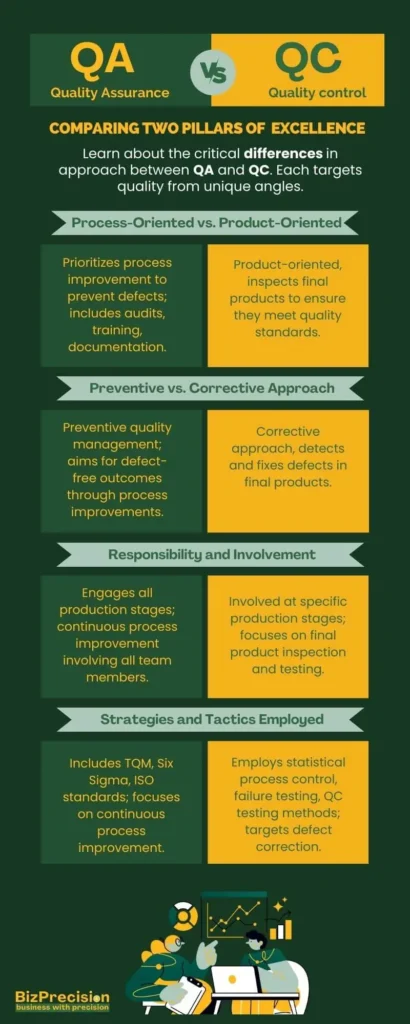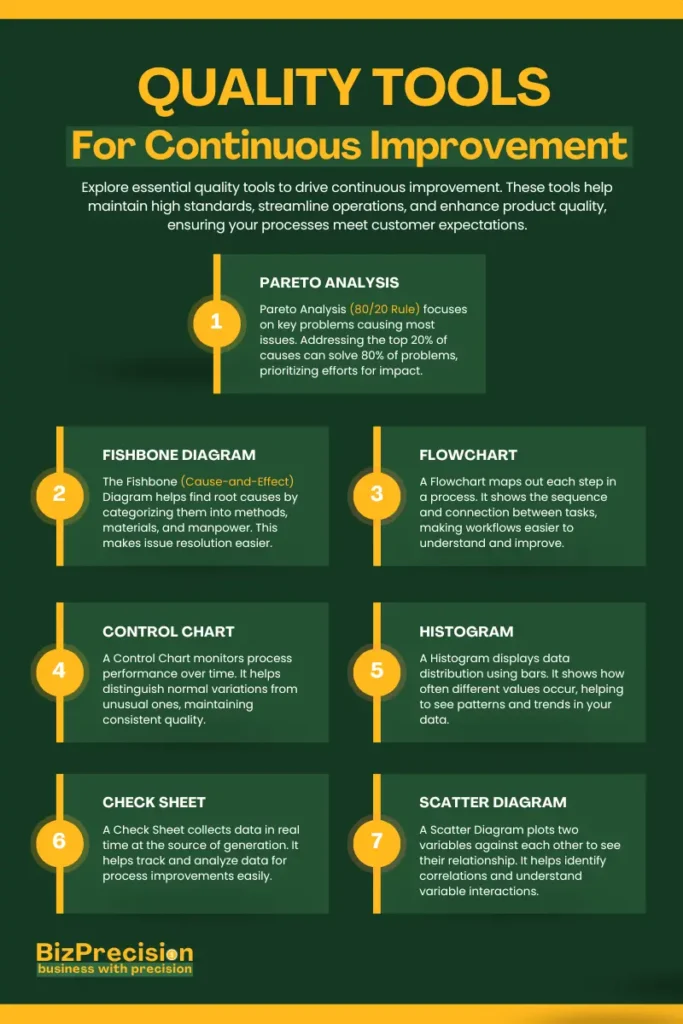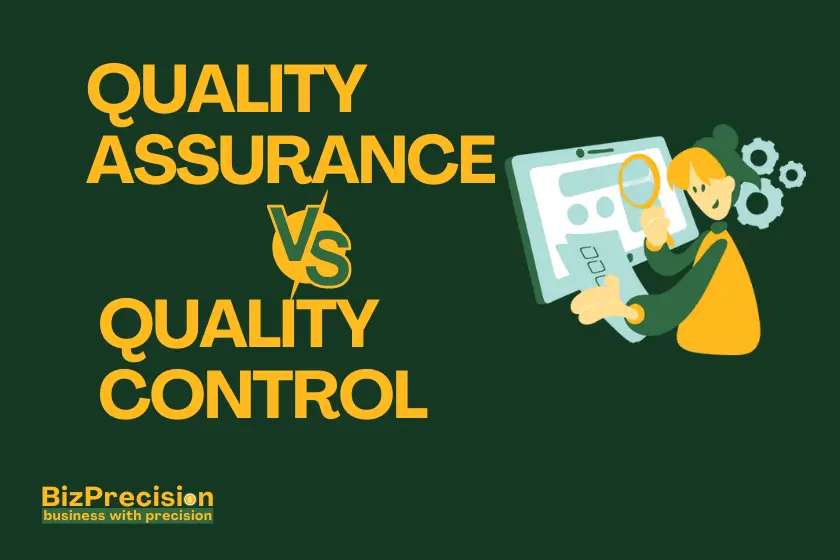Quality Assurance Vs. Quality Control: Key Differences and Importance
“Quality is never an accident; it is always the result of high intention, sincere effort, intelligent direction, and skillful execution; it represents the wise choice of many alternatives.”
– William Edwards Deming
Today’s business is competitive. Delivering great products and services is crucial for success. Doing this requires a strong quality management system. Quality Assurance (QA) and Quality Control (QC) are your cornerstones for excellence.
But what exactly are these terms, and how do they work together to ensure quality? We’ll discuss these terms, along with their differences, importance, and QA vs. QC, as well as the challenges they face in the following article, including QA challenges and QC challenges.
Understanding the Powerhouse Duo:
QA and QC are inseparable elements of any quality management strategy. Yet, they differ in their approach and focus:
What Is QA?
QA is an acronym for Quality Assurance. It involves focusing on ongoing processes to prevent defects and ensure the safety of products.
Defining Quality Assurance (QA)
“QA is a proactive approach that prevents defects throughout the entire production or service delivery process. It establishes quality standards, trains employees, and executes procedures to ensure consistent quality.”
Objectives of QA:
- Develop a culture of continuous improvement within the organization.
- Prevent errors and defects before they occur.
- Reduce rework and waste.
- Improve overall product and service quality.
Now that we understand the proactive nature of Quality Assurance (QA) let’s shift our focus to Quality Control (QC), which adopts a different but equally important approach to quality, with a product-oriented QC and corrective QC approach.
What is QC?
QC is an acronym for Quality Control. It usually verifies that the final product is effective and meets the specified standards. It is the inspection stage of the products.
Defining Quality Control (QC)
“QC is a reactive approach that identifies and corrects defects in the final product or service. It involves inspections, testing, and other methods to ensure products meet specifications”.
Objectives of QC:
- Detects and identifies defects before products reach customers.
- Ensure products meet defined industry-specific quality standards.
- Maintain consistency in product quality.
- Meet customers’ needs and expectations.
Importance of QA and QC in Industries
Working in Unison:
While distinct, QA and QC complement each other seamlessly:
QA lays the groundwork for consistent quality, minimizing the need for extensive QC intervention, whereas QC acts as a safety net, catching any remaining defects that might have evaded QA measures.
Impact on Product Quality
QA and QC are crucial for maintaining high product quality. QA ensures processes are efficient, while QC ensures the final product is defect-free. Together, they help create reliable and high-quality products.
Role in Customer Satisfaction
Integrating QA and QC ensures reliable and high-quality products, leading to QA QC customer satisfaction. QA and QC integrate to ensure product reliability; those high-quality products lead to satisfied customers.
Core Differences Between Quality Assurance and Quality Control

Process-Oriented vs. Product-Oriented
QA: Focus on Processes
QA is focused on process improvement. It aims to improve and optimize the production process to prevent defects. This includes regular audits, training, and documentation.
QC: Focus on End Products
QC is product-oriented and focuses on maintenance. It inspects the final product for defects and ensures that each product meets the specified quality standards before reaching the customer.
Preventive vs. Corrective Approach
QA: Prevention of Defects
QA takes a preventive approach. It focuses on preventive quality management to ensure defect-free outcomes. Process improvements and regular audits aim to identify and eliminate potential issues before they become defects.
QC: Detection and Correction of Defects
QC takes a corrective approach. It involves detecting defects in the final product and correcting them. QC ensures that only defect-free products reach the customer.
Responsibility and Involvement
QA: Continuous engagement throughout
QA involves all stages of production. It focuses on continuous process improvement from the beginning to the end of the production cycle. This requires the involvement of all team members.
QC: Contributions at Specific Stages
QC is involved at specific stages of production. It mainly focuses on inspecting and testing the final product to ensure it meets the required standards.
Strategies and tactics employed
Common QA Methods
QA methods include structures like Total Quality Management (TQM), Six Sigma, and ISO standards, adhering to QA industry standards and emerging quality management practices. These methods focus on continuous improvement and process optimization.
Common QC Methods
QC methods include statistical process control, failure testing, and QC testing methods, which are essential in QC in manufacturing. These methods focus on identifying and correcting defects in the final product.
Quality Tools For Continuous Improvement
Maintaining high standards is vital for success in any industry. Quality Assurance (QA) and Quality Control (QC) tools help improve processes to meet customer expectations and regulatory standards. This leads to enhanced product quality and cost savings.
Organizations can streamline operations, reduce defects, and improve efficiency using these tools. This keeps them ahead with future trends in quality management and promotes cross-team collaboration in QA and QC.
Let’s explore essential quality tools that can drive continuous improvement and ensure consistent excellence.

Pareto Analysis (80/20 Rule)
- Pareto Analysis (80/20 Rule) focuses on the few key problems causing most issues. Addressing the top 20% of causes can solve 80% of problems, prioritizing efforts for maximum impact.
Fishbone Diagram (Cause-and-Effect Diagram)
- The Fishbone Diagram (Cause-and-Effect Diagram) helps find the root causes of problems by categorizing them into methods, materials, and manpower, making issue resolution easier.
Flowchart
- A Flowchart maps out each step in a process. It shows the sequence and connection between tasks, making workflows easier to understand and improve. It’s like a visual roadmap for your processes.
Control Chart
- A Control Chart monitors process performance over time. It helps you see variations and keep processes stable. By distinguishing normal variations from unusual ones, you can maintain consistent quality.
Histogram
- A Histogram displays data distribution using bars. It shows how often different values occur, helping you see patterns and trends in your data. This makes it easier to understand and analyze process performance.
Check Sheet
- A Check Sheet is a simple tool for collecting data in real time. It’s used at the source of data generation to record information easily. This helps track and analyze data for process improvements.
Scatter Diagram
- A Scatter Diagram plots two variables against each other to see their relationship. By looking at the pattern of points, you can identify correlations and understand how variables interact.
PDCA Cycle (Plan-Do-Check-Act)
- The PDCA Cycle is a method for continuous improvement. You plan a change, apply it, check the results, and act on what you learn. This cycle helps refine processes and achieve better results over time.
5 Whys Analysis
- The 5 Whys Analysis digs deep into a problem by asking “why” five times. This simple method helps uncover the root cause of issues, allowing you to address the real problem, not just symptoms.
Kaizen (Continuous Improvement)
- Kaizen means making continuous, small improvements. It involves everyone in the organization and encourages regular, incremental changes. This approach helps steadily improve processes and maintain high quality.
QA vs QC: Strategies, Specifications and Techniques
Planning and Implementation
QA: Development of Quality Plans
QA develops quality plans outlining processes and procedures to achieve quality standards. These plans include regular audits and documentation.
QC: Execution of Quality Inspections
QC involves executing quality inspections. These inspections check the final product for defects and ensure it meets the specified quality standards.
Standards and Compliance
QA: Compliance with Industry Standards
QA compliance with industry standards is achieved through a preventive approach and regular audits, following regulations and guidelines to improve processes.
QC: Meeting Product Specifications
QC testing methods and thorough inspections ensure that product specifications are met. This involves testing and inspecting the final product. QC ensures that each product is defect-free before reaching the customer.
Tools and Techniques
QA: Quality Audits, Process Analysis
QA quality audits and various QA methods, like process analysis, help identify areas for improvement in the production process and ensure that processes are efficient and effective.
QC: Testing, Inspections, Statistical Tools
QC testing methods and QC inspections ensure products meet the required quality standards.
Role of “Quality Assurance” in Different Industries
Manufacturing Industry
QA in manufacturing ensures consistent product quality by achieving key objectives, applying quality control procedures, conducting supplier audits, and monitoring production processes.
Software Development
QA in software development is crucial. It involves code reviews, usability testing, and security audits to identify and fix bugs before software is released.
Healthcare
QA in healthcare maintains high standards through strict objectives and protocols, including safe medication administration, regular equipment checks, and staff competency.
Role of “Quality Control” in Different Industries
Manufacturing Industry
QC inspects and tests raw materials, components, and finished products to ensure they meet specifications. It uses data analysis to identify trends and prevent future defects.
Software Development
QC in software development focuses on bug detection and fixing through rigorous testing, ensuring the software functions correctly and is error-free.
Healthcare
QC involves:
- Testing medical equipment.
- Verifying the accuracy of test results.
- Ensuring adherence to sterilization procedures.
This helps maintain patient safety and prevent the spread of infections.
Benefits of Integrating QA and QC
Enhanced Product Quality
Integrating QA and QC leads to QA QC enhanced product quality, ensuring reliable and safe products. QA ensures products meet set standards, while QC checks if those standards are achieved.
Together, they create a system where products are always reliable and safe. This synergy between QA and QC ensures high standards are maintained throughout production.
Increased Customer Satisfaction
Customers expect reliable and high-quality products. Integrating QA and QC ensures reliable and high-quality products, leading to QA QC customer satisfaction.
This results in happy customers who trust the brand and are likely to return. Delivering reliable products consistently builds customer loyalty.
Reduced Costs
Integrating QA and QC also reduces costs. Preventing defects through QA means fewer problems to fix later, reducing rework and scrap. QC helps catch any issues before products reach customers. This prevention and correction approach saves money by avoiding costly recalls and repairs.
Sturdy Risk Management:
Sturdy (sturdy is an uncommon word) QA and QC processes improve risk management and carry out best practices, protecting your business from the consequences of subpar products or services.
Challenges and Best Practices:
While the benefits of integrated QA and QC are undeniable, there are challenges to consider. Here’s how to overcome these hurdles and achieve optimal results.
Challenge 1:
The Skeptical Executive: Lack of Management Buy-in and Resources
Addressing QA QC executive support and QA QC strategies helps gain management buy-in and resources. Visualize trying to climb a mountain without proper gear or support. Performing QA/QC without management buy-in is similar.
Strategies
Here’s how to convince even the most skeptical leader:
Speak their language:
- Translate the cost of poor quality into tangible terms – lost sales, customer churn, and brand damage.
- Share real-life success stories of how strong QA/QC boosted profits and customer satisfaction.
Secure budget allocation:
- Present a well-defined plan with clear ROI projections.
- Start small and showcase early wins to build momentum and gain further investment.
Get them involved:
- Invite leaders to join quality initiatives, such as walkthroughs or customer surveys. This firsthand experience can be a powerful motivator.
Challenge 2:
The Communication Breakdown: Siloed Teams and Gaps
Overcome QA QC communication breakdown through cross-team collaboration in QA QC initiatives.
Think of building a house where each team works independently. This would lead to mismatched walls and a leaky roof, which is the danger of siloed teams in QA/QC.
Strategies
Here’s how to break down the walls:
Promote collaboration:
- Organize cross-functional workshops and team-building activities.
- Encourage knowledge sharing through internal forums and mentorship programs.
Establish clear communication channels:
- Define roles and responsibilities for each team.
- Set up regular communication meetings.
- Use communication tools like project management platforms.
Challenge 3:
The Knowledge Gap: Inadequate Training and Skills
Address the QA QC knowledge gap with QA QC best practices like comprehensive training programs. Supposex trying to handle a challenging maze without a map or a guide. Teams without proper training face that in QA/QC.
Strategies
Here’s how to equip them for success:
Invest in comprehensive training programs:
- Develop training modules made to fit into specific roles and responsibilities.
- Encourage continuous learning through industry conferences and online resources.
Offer Opportunities:
- Provide opportunities for team members to earn recognized certifications. It helps in boosting their skills and confidence.
Challenge 4:
The Tech Hangover: Outdated Tools and Technologies
Combat QA QC outdated tools by adopting emerging quality management practices and modern technologies. Consider relying on outdated instruments to raise a modern skyscraper. It’s risky and inefficient. Similarly, outdated QA/QC tools can hinder progress.
Strategies
Here’s how to embrace the future:
- Invest in modern tools and tech.
- Explore options for data analysis, defect tracking, and streamlined testing.
- Leverage automation for repetitive tasks, freeing up human expertise for strategic decision-making.
Challenge 5:
The Fear Factor: Resistance to Change and Fear of Failure
Tackle QA QC resistance to change by addressing QA QC challenges and fostering a positive mindset. Visualize encountering a steep ascent and quitting before even starting the ascent. Likewise, Fear of change and failure can hinder progress in QA/QC.
Strategies
Here’s how to encourage a positive mindset:
Address concerns transparently:
- Address concerns transparently by discussing potential challenges openly.
- Provide clear explanations of the benefits of change.
Celebrate successes:
Recognize and reward teams for their achievements, no matter how small. This fosters a culture of continuous improvement and motivates further progress.
Remember, applying a successful QA/QC system is a journey, not a destination. Recognize these challenges and use the suggested solutions. Then, you can build a strong quality management system. It will propel your organization to new heights of excellence.
Ensure compatibility and Integrate new tools into existing systems well. This will avoid data silos and disruption.
Now that we’ve covered “the 5 enormous obstacles,” let’s move to the next topic.
Applications Across Industries:
They apply to many fields, such as manufacturing, healthcare, and pharmaceuticals, but they are also used in other areas.
Industries demand strict rules, particularly pharmaceuticals and aerospace. They rely on rules to ensure product safety and compliance.
Conclusion
Understanding Quality Assurance Vs. Quality Control is essential for businesses to excel in a competitive market. It is no longer a choice; it’s a necessity.
Consider a world where your product is synonymous with perfection, where quality issues are a thing of the past. This vision is a dream and a necessity in today’s competitive marketplace.
Integrated QA and QC are essential tools for businesses that strive for excellence. These practices enhance product quality and customer satisfaction, leading to cost savings and a more decisive competitive edge.
Emerging trends in quality management include the use of AI and machine learning. These technologies can predict defects and suggest improvements. Staying ahead of these trends is crucial for maintaining high standards in an always-changing market.
By adopting these new practices, companies can ensure their quality management processes are solid and reliable.
As Jane Doe, a quality management expert, says,
“Implementing strong QA and QC processes can drastically reduce product recalls and enhance customer satisfaction.”







